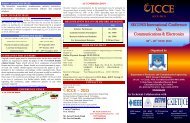Download PDF - Krishna Institute of Engineering and Technology
Download PDF - Krishna Institute of Engineering and Technology
Download PDF - Krishna Institute of Engineering and Technology
Create successful ePaper yourself
Turn your PDF publications into a flip-book with our unique Google optimized e-Paper software.
International KIET Journal <strong>of</strong> S<strong>of</strong>tware <strong>and</strong> Communication Technologies (IKJSCT)Volume 1, Issue 1, pp: 7-15, April 20133.Usability assessment st<strong>and</strong>ards <strong>and</strong> models:Literature reviewUsability measurement st<strong>and</strong>ards <strong>and</strong> modelsdefine some metrics or parameters to assess theUsability <strong>of</strong> a particular s<strong>of</strong>tware application. Thereare various models proposed to assess theUsability. Here a review is provided <strong>of</strong> theseexisting models. This section will contain theirwork done <strong>and</strong> some <strong>of</strong> the limitations <strong>of</strong> thesemodels which gave the motivation to propose anew model. Some <strong>of</strong> these models are ISO9241,ISO/IEC9126, IEEE Std.610.12-1990, metrics forUsability st<strong>and</strong>ard in computing (MUSiC), qualityin use integrated measurement (QUIM).3.1 Traditional quality models addressing theUsabilityThere are various traditional quality models thataddress the Usability. These models are as follows:3.1.1 McCall [4]This is a hierarchical model which has 11 qualityfactors, 25 quality criteria <strong>and</strong> 41 quality metrics.This model has 4 criteria for Usability named asConstantine &Lockwood [8]Schneiderman[7]Nielsen [6]operability, training, communicativeness, I/O rate,I/O Volume.3.1.2 Boehm model [5]This model defines the Usability as the context towhich product is convenient <strong>and</strong> practical to use.Similar to McCall model this is also a hierarchicalmodel. It has total 19 quality factors includingproduct utility, portability <strong>and</strong> maintainability.Utility is further divided into reliability, Usability<strong>and</strong> efficiency. In this model unlike Mc Call modelit is not necessary that metrics are related to samefactors. These can vary according to circumstances.This causes uncertainty.3.1.3 Nielsen <strong>and</strong> Schneiderman model [6, 7]These models define the Usability through fivequality attributes. These five attributes <strong>of</strong> Usabilityare learnability, effectiveness, satisfaction, errortolerance <strong>and</strong> memorization. This model iscriticized by various graphics designer because itlacks in readability <strong>and</strong> typography.Different models have defined the Usabilitythrough different attributes. These are listed infollowing table1.Preece et al.[9]Shackel [10]Efficiency in useSpeed <strong>of</strong>performanceEfficiencyuse<strong>of</strong>ThroughputEffectiveness(Speed)learnability Time to learn Learnability(Ease <strong>of</strong>learning)Learnability(Ease <strong>of</strong>learning)Learnability(Time tolearn)RememberabilityRetentionovertimeMemorabilityLearnability(Retention)Reliability in useUser satisfactionRate <strong>of</strong> errorsby usersSubjectivesatisfactionErrors/safety Throughput Effectiveness(Errors)Satisfaction Attitude AttitudeTable 1 — Usability attributes <strong>of</strong> various models3.2 ISO st<strong>and</strong>ards for Usability8 | P a g e




